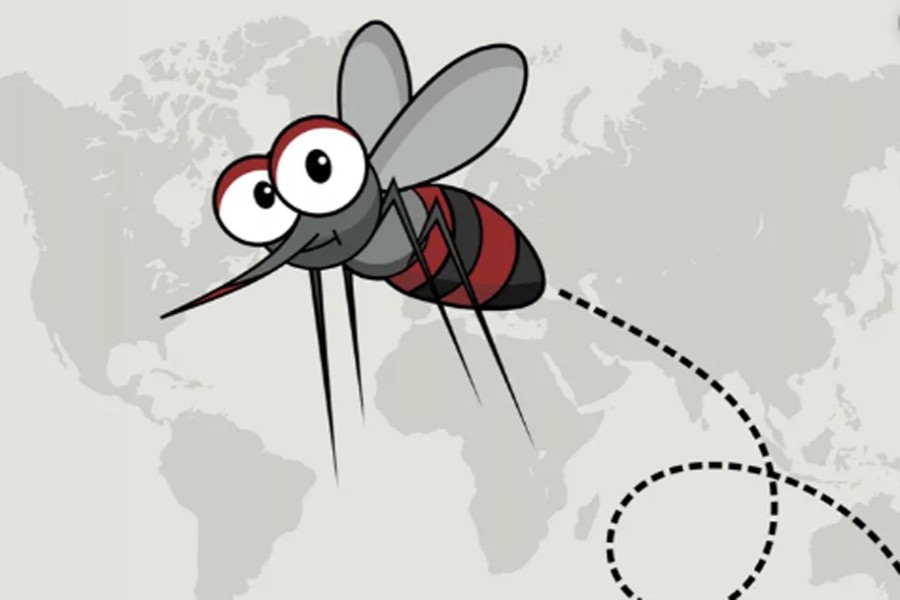There was hardly a better time than this year to observe the World Mosquito Day. Dr. Ronald Ross's ground-breaking discovery that female anopheles acts as the vector of malaria to both humans and cattle is commemorated as the World Mosquito Day on August 20 every year. Marauding malaria may have become a distant memory but has not quite disappeared. It still claims 800,000 worldwide annually.
If malaria's carrier anopheles has been significantly brought under control in this part of the world, the dangerous foe that scientists estimate has accounted for at least one-third of mortals on the globe is on the prowl in Africa. However, this year seems to have staged a rehearsal of what havoc another vector called aedes aegyptus may wreak here and elsewhere in the future. The numbers of deaths caused by dengue -a fatal and debilitating disease aedes spreads -and patients have swelled at an accelerated rate between late July and August 6 last. This, according to the Directorate General of Health Services, has been declining since August 7. But still around 1,500 more people are diagnosed daily with the disease.
Worldwide the incidence of dengue has marked a 30-fold rise in the past 30 years. Scientists warn that the incidence may rise further with the global warming as there is a link between climate change and the prevalence of the life-threatening diseases. And aedes does spread not only deadly dengue but also yellow fever, zika and chikungunya. Dengue claims lives but chikungunya may leave lasting debilitating impacts with joint pains and congenital anomalies in the new-borns if their mothers are attacked during pregnancy. Of the 3,500 species of mosquitoes the world over, another vector is culex infamous for transmitting west nile fever and this has reportedly affected 90 per cent of the US and Japan.
The fact is that mosquitoes have existence since before human beings. They are yet to be eradicated although at times man has prevailed over them in some form or other. In the late 1800s and first half of the 1900s, as many as 100 million people in the undivided sub-continent were afflicted with malaria and of which 1.0 million were killed by the disease. Dengue has not broken out to a proportion like that but this year's toll and range of the disease unfold an ominous picture for the future.
The first case of dengue in the country was reported from Chattogram. But the port city happily did not become a good host to the disease initially. In its place the capital city started to be a hotbed of the scourge. Why this year the disease has attained the unprecedented order is yet to be clearly explained. One explanation is that the insecticide used for fumigation did not work because either it was wrong type or the mosquitoes -both aedes and culex -have developed immunity to it. Then again, reports had it that the city corporations delayed inordinately to import fresh effective anti-mosquito pesticide for fumigation.
One of the two mayors even held a video-conference to know how Kolkata had tackled the problem of aedes mosquitoes. The mayor even declared that a delegation would be sent to Kolkata to acquire a detailed picture of the dengue management programme in that city boasting many things in common with Dhaka. In the meantime, some public awareness programme has also been launched under which corporation teams pay house-to-house visits in order to see for themselves how residents are maintaining rules against mosquito breeding.
All such efforts, however, look somewhat directionless and the High Court has, not for nothing, expressed its dissatisfaction over the two corporations' role in managing the situation. Indeed, efforts expended so far have been isolated and sporadic without coordination and effective guidance. The two mayors have played more to the gallery than making a thorough assessment of the action plan to destroy the breeding grounds of aedes.
It is common knowledge that without proliferation of aedes mosquitoes, the disease cannot go on a rampage of this order. So the first thing was to destroy the mosquito's breeding grounds. This year rains were sparse but intermittent which certainly is an ideal condition for aedes to raise fresh batches of its kinds. It is also a precondition that this species does not lay its eggs in water that is not clear. This means that keeping a tab on all possible receptacles of rain water would have been enough to restrict the breeding of the mosquito. Overturning the accumulated water would have been enough in certain cases. Where no such ploy worked, fumigation with effective pesticide was necessary. But it seems, the city corporations missed the wood for the trees.
The disease could not take hold like this if people were alerted before it coming to this stage. On the World Mosquito Day, at least, a strong message could be disseminated through its observance in which people's participation could be ensured for destruction of all possible breeding grounds. From egg to an adult mosquito, aedes has a life cycle of only 8-10 days. Of this time, pupa takes 2-3 days to become a flying mosquito. This leaves humans to deal with a potential dengue vector only for 4-5 days. If they have no place to breed, the fever can be drastically brought under control. This is where focus should be directed to eliminate the insect.


